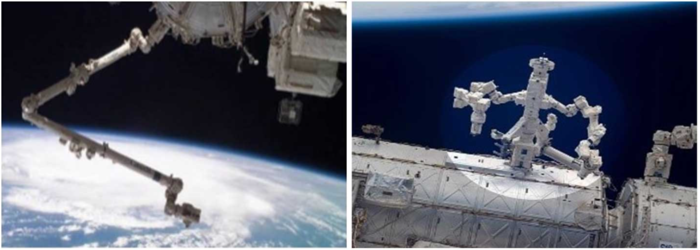The use of space intelligent robots to achieve space exploration and space resource utilization is an unavoidable choice for the field of space automation technology.
 Chinese robotic manipulator system (figure 3(b)) consists of a large space robotic arm and a small space robotic arm. Image Credit: Space: Science & Technology.
Chinese robotic manipulator system (figure 3(b)) consists of a large space robotic arm and a small space robotic arm. Image Credit: Space: Science & Technology.
China began with the grand success of the Tianhe Core Module in 2021 and plans to construct a large-scale, long-term manned national space laboratory between 2021 and 2022, which will eventually become China’s Space Station (CSS), raising more demands for space intelligent robot technological development.
However, space robots face obstacles in large-range stable motion, elevated dexterity and secure manipulation, precision sensing and high-precision measurement due to the hostile environment that is space, which includes microgravity, complicated illumination and powerful radiation.
Xiao Huang of the Beijing Institute of Technology reviewed, analyzed and summarized the technical status and future development trend of space intelligent robots for the on-orbit required conditions of space stations, satellites and large space structures in a research study recently published in Space: Science & Technology.
The author first concentrated on space intelligent robots for usage in space stations. The space manipulators are explored, including Canadarm II and the Chinese robotic manipulator equipment.
Robot astronauts, on the other hand, have been named as one of the important research directions of space intelligent robots since directing robots like astronauts to conduct human-like actions and operations has proven to be an effective technique to support or replace astronauts.
However, in a confined microgravity space, it is challenging to perform a wide variety of stable movements and safe dexterous manipulation, and it is also difficult to successfully check the robot astronaut’s 3D motion on the ground.
As a result, forming a parameterized representation of the law and studying the theory of motion planning and monitoring that is fitted to the space environment is a scientific problem that must be solved as soon as possible in the case of robot astronauts. Meanwhile, robotic manipulation relies heavily on computer vision.
The mirror-like coating of the space device may also potentially cause refraction and reflection of light, high-energy particle radiation and other complicated interference surroundings, which seriously interrupts the functionalities of the operating objects and pose a challenge to existing image-processing techniques.
Following on from that, research into a space intelligent robot for satellite on-orbit maintenance is carried out. The “Orbital Express” program, which focuses on cooperative space objects, and the “Phoenix Spacecraft Servicing Program,” which focuses on non-cooperative space objects, are both examined.
The author concluded the important technologies to support the on-orbit service as follows based on an examination of existing studies, taking into account the harsh space environment of high-speed flight and microgravity: design of high-precision rigorous coupling manipulators, accuracy safe and dexterous manipulation technology, multi-robot collaborative control technology, quick tool replacement, and tooling system design innovation, and modular satellites and cellular satellites technology.
Moreover, the author reviewed current breakthroughs in space intelligent robots for on-orbit assembly of large-scale structures aimed toward space. To demonstrate the developing tendencies in linked technology, four exemplary space robots or robotic projects are given.
(a) The Skyworker is a connected mobile robot developed by Carnegie Mellon University that can move by providing a response force to objects rather than gripping hooks or handrails. Skyworker is primarily used for the transfer, installation and management of big payloads, such as solar cell array assembly on-orbit.
(b) Tethers Unlimited, Inc. of America presented the SpiderFab idea in 2012, which primarily employs the 3D printer and materials transported by the multi-arm space robot to manufacture massive trusses on-orbit and combine them to build a large-scale system.
(c) The James Webb Space Telescope (JWST) is a massive space telescope being built by many aerospace agencies to enable a wide range of astronomical and cosmological research.
(d) Chinese researchers have developed a two-stage symmetric reflected space-based solar power station (SSPS) design scheme as well as a multi-rotary joint SPS design phase. Overall, large-aperture space antennas, large-aperture space telescopes and large-scale solar power plants are critical for human exploration and resource utilization in space.
Furthermore, due to the carrier’s size and rocket-bearing capacity constraints, it is difficult to set up a large-scale structure in space, and it is also hard for humans to perform on-orbit assembly of large-scale spacecraft due to the physiological constraints.
As a result, the author stated that fundamental technologies such as a large inertia weight handling system, a large-range fast and smooth moving system, a micro-nano high-precision space measuring system and unique tools and systematic equipment are needed to support on-orbit building.
Journal Reference:
Jiang, Z., et al. (2022) Progress and Development Trend of Space Intelligent Robot Technology. Space: Science & Technology. doi.org/10.34133/2022/9832053.